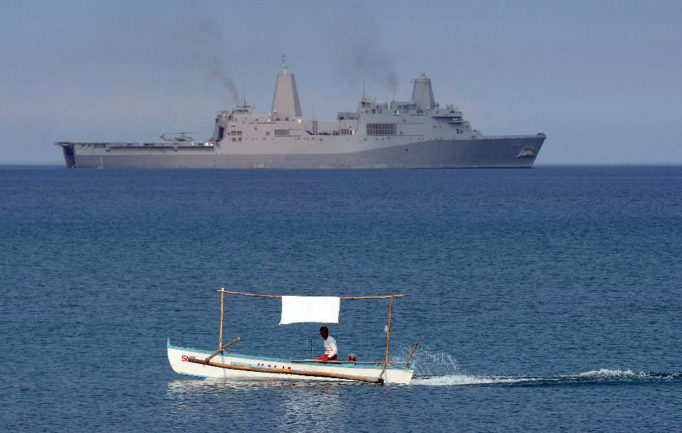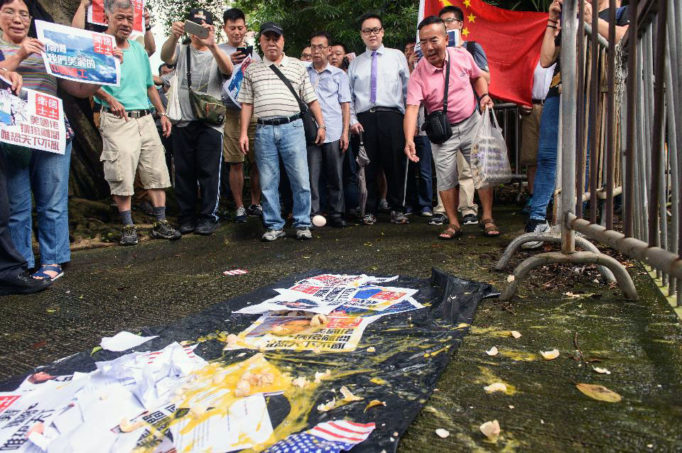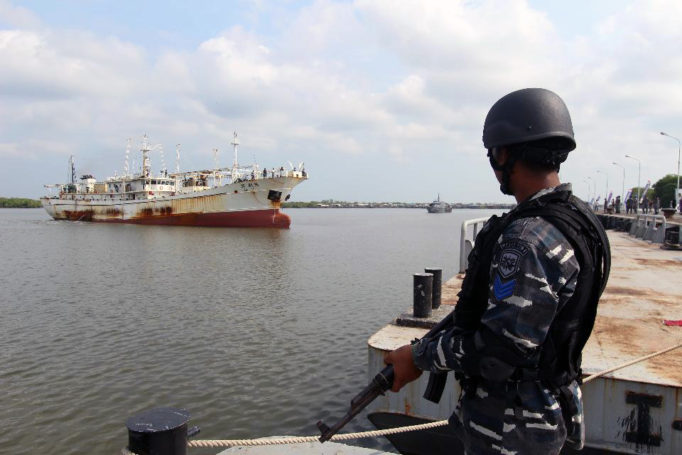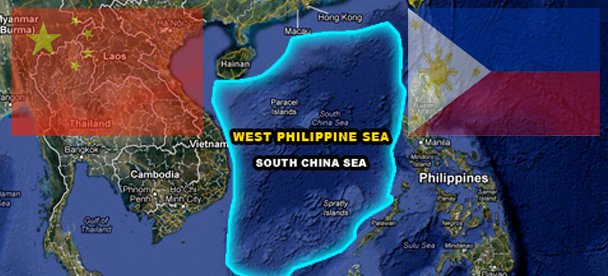China is building militarized islands in the South China Sea and ignoring international law, including in Philippine territory. Experts think China plans to build a new base on strategic Scarborough Shoal. That calls for economic sanctions, and triggering of the U.S.-Philippine defense treaty.
On Monday (10-April-2017), Reuters reported China Coast Guard and industrial fishing ship operations at Scarborough Shoal, the Philippines, which are arguably a violation of Philippine territorial sovereignty. The report said China is now allowing Philippine fishermen at the shoal, but restricting full access to the lagoon. The ratio of Chinese to Philippine fishing boats on Monday was about 10:1. The China Coast Guard ships are typically armed, and have shown to be armed at the shoal. Chinese ships at the shoal on Monday included at least two approximately 75-meter industrial fishing trawlers. In addition, according to Reuters, the Chinese Foreign Ministry confirmed that the China Coast Guard was at the shoal to “administer fishing and preserve the peace.” This is arguably a direct violation of Philippine sovereignty at what The Hague’s Permanent Court of Arbitration (PCA) found to be an “island” last year. The U.S.-Philippine Mutual Defense Treaty of 1951 applies to “islands”, and so should be triggered by China’s continued armed occupation of Scarborough.

A Filipino fisherman is seen past the US Navy amphibious transport dock ship USS Green Bay (LPD-20) during an amphibious landing exercise on a beach at San Antonio in Zambales province on April 21, 2015, as part of annual Philippine-US joint maneuvers some 220 kilometres (137 miles) east of the Scarborough Shoal in the South China Sea. The Philippines voiced alarm April 20 about Chinese ‘aggressiveness’ in disputed regional waters as it launched giant war games with the United States that were partly aimed as a warning shot to Beijing. Photo Credit: TED ALJIBE/AFP/Getty Images
China’s occupation is an affront to the Philippine sovereignty, territorial integrity, and the Constitution of 1987, according to which “The State shall pursue an independent foreign policy. In its relations with other states, the paramount consideration shall be national sovereignty, territorial integrity, national interest, and the right to self-determination,” and that “The State shall protect the nation’s marine wealth in its archipelagic waters, territorial sea, and exclusive economic zone, and reserve its use and enjoyment exclusively to Filipino citizens.”
If allowed to continue, Chinese occupation of the shoal degrades the Philippine environment, sovereignty, and the likelihood that it will eventually regain control of the shoal. The longer China has control of the shoal, the more likely it is to build planned military facilities there, and the less likely it will return Scarborough Shoal to the Philippines. It is critical for the natural habitat at Scarborough, and for the Philippines’ sovereignty and territorial integrity, that the Philippines, U.S., and allies immediately increase pressure on China, through economic sanctions and activation of the defense treaty if necessary, to vacate the shoal and return it to Philippine administration.

A pro-China protester throws eggs at photos of US President Barack Obama and torn copies of the ruling by the Permanent Court of Arbitration in The Hague against Beijing’s extensive claims in the South China Sea, outside Hong Kong’s United States Consulate on July 14, 2016. About 50 pro-China activists marched to Hong Kong’s United States Consulate holding placards that read ‘Ruling is a piece of paper’, ‘US sowing discord and stirring up trouble’, as they shouted slogans such as ‘No Compromise on South China Sea’ and ‘Shameless US’. The protesters also threw eggs on pieces of paper placed on the ground — featuring the picture of US President Barack Obama — outside the consulate. Photo Credit: ANTHONY WALLACE/AFP/Getty Images
China is in the process of large-scale environmental destruction at Scarborough Shoal and other parts of the South China Sea (SCS), including through widespread destruction of endangered coral and harvesting of endangered species such as giant clams and sea turtles. China has been turning barely-submerged shoals in the South China Sea into militarized artificial islands, replete with military runways and docks large enough for aircraft carriers and nuclear missile submarines. Some analysts think China may eventually create underwater submarine bastions or harbors in the South China Sea, including at Mischief Reef and Scarborough. A Chinese military source and maritime experts said last year that China plans to turn Scarborough into a military base.
I visited Scarborough Shoal in June 2016, Philippine Independence Day, on a “Freedom Voyage” organized by the Kalayaan Atin Ito activist group. Two 2,580-ton China Coast Guard cutters with light cannon, and another medium-sized China Coast Guard boat, made numerous dangerous passes, charges, chases, and blocking maneuvers of our 30-meter wooden fishing boat. In one case, the medium-sized China Coast Guard boat charged us to about 4 meters, then began rocking in a way that made our boat pitch violently up and down. Once we made it past the larger Coast Guard boats to the shoal, Filipino activist swimmers carrying Philippine and U.N. flags swam towards the shoal, and could have been killed on multiple occasions as two China Coast Guard speed boats circled them aggressively and backed their spraying propellers towards the swimmers within about 3 feet of slicing into their flesh.
Over the course of about an hour, five very brave swimmers were undeterred, and as swimmer and leader of the expedition Joy Ban-eg diverted two China Coast Guard speed boats, from which she was forced to push off on multiple occasions, swimmer Mariel Ipan made it past the Chinese to raise a small Philippine flag on the shoal that day. I was there and I saw it happen. The next day, Ms. Ipan wrote on Facebook, “My near death experience at Scarborough Shoal; could’ve been the Sweetest Death.”

This picture taken on April 23, 2016 shows a member of the Indonesian navy standing before the Chinese trawler ‘Hua Li-8’ (L) in Belawan, North Sumatra. Indonesian warships detained a Chinese trawler allegedly operating illegally in Indonesian waters, just weeks after a confrontation between vessels from the two countries caused tensions, the navy said on April 24. Photo Credit: ABIMATA HASIBUAN/AFP/Getty Images.
Kalayaan Atin Ito’s 2016 protest of China’s occupation of Scarborough was not official, but it had a maximum of heart and patriotism. It was one way in which the Philippine people continued to demonstrate non-acquiescence to China’s claim and aggressions, and to show the Philippine government that they demand continued assertive measures to maintain Philippine sovereignty, an independent foreign policy, and the territorial integrity of the Philippines. Official non-acquiescence is critical to the maintenance of the Philippines’ claims to sovereignty over Scarborough, and the rest of the Philippines’ territory and exclusive economic zone (EEZ) within China’s nine-dash line.
According to the PCA Award in the Philippines v. China case, “In practice, to establish the exclusive historic right to living and non-living resources within the ‘nine-dash line’, which China now appears to claim, it would be necessary to show that China had historically sought to prohibit or restrict the exploitation of such resources by the nationals of other States and that those States had acquiesced in such restrictions.” Some international lawyers will argue that China’s actions over the last 20 years, now that the dispute has started, will not adversely affect the Philippine sovereignty claim. But China is progressively destroying the shoal. To be on the safe side of the sovereignty issue, and to increase political as well as legal pressure, I think it critical to physically demonstrate regular official as well as popular non-acquiescence to China’s claim. It is a political as well as legal issue, so the duty to defend the sovereign territorial rights of the Philippine nation requires frequent public demonstration.
__________
This article has been reprinted with permission from www.Forbes.com. To view the article, go to: https://www.forbes.com/sites/anderscorr/2017/04/14/take-defense-treaty-action-for-philippine-sovereignty-in-south-china-sea/
Anders Corr has worked in military intelligence for five years, including topics on nuclear weapons, terrorism, cyber-security, border security, and counter-insurgency. He covered and visited Africa, Asia, Europe, Latin America, and the Middle East; and worked in Afghanistan for one and a half years. He holds a Ph.D. in Government from Harvard University, and a B.A. and M.A. in international relations from Yale University (Summa cum laude). His company, Corr Analytics, provides political risk analysis to commercial, non-profit, and media clients, and publishes the Journal of Political Risk. He is editing a series on the South China Sea conflict. The author is a Forbes contributor.
